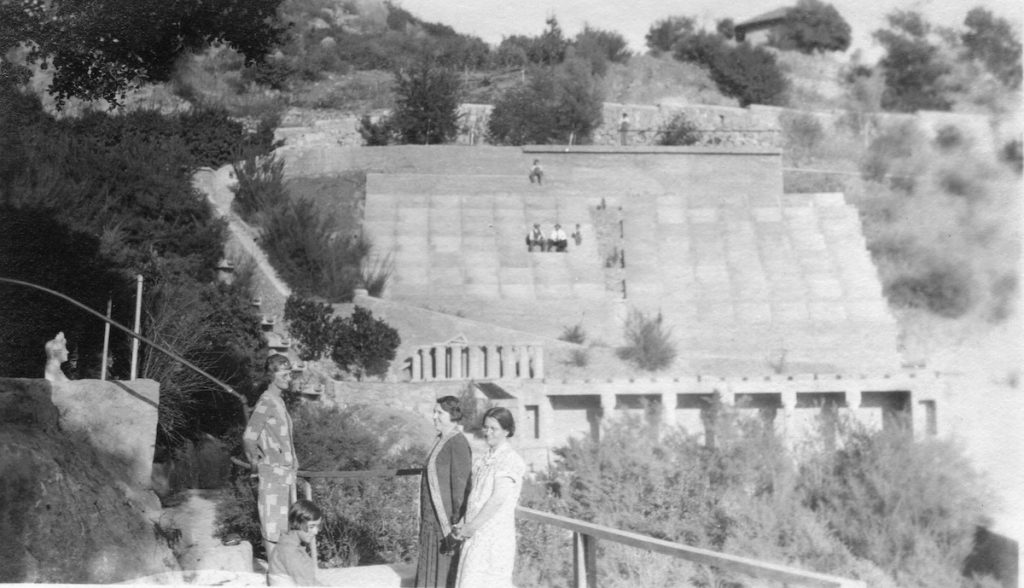Shakespeare and Skateboarders Between the Sky and Sea

Synchronized swimmers, Shakespearean actors, and trespassing skateboarders have all felt the magic of Mar y Cel, although many of those who live below the singular arched wall that still stands today have yet to hear the stories of the land between the sky and the sea.
Henry Bothin, the original owner of Mar y Cel, was born in Ohio in 1853. After moving to San Francisco as a teenager, Bothin opened a spice and coffee factory. He then moved his pursuits over to the steel industry, becoming the president of the Judson Manufacturing Company and investing his fortune in large commercial real estate. By the turn of the century, Bothin was the largest individual commercial landowner in San Francisco. With his success, Bothin created the Bothin Helping Fund in 1917, which was the second oldest private foundation in the West and was initially aimed at eliminating tuberculosis. More than a century later, Bothin’s descendants have continued his fund under the name the Bothin Foundation, which focuses on “making capital grants to social service, education, art, and environmental nonprofit organizations that provide direct services to: disadvantaged children and youth (ages 0 to 24), low-income families, and people with disabilities,” according to the Pacific Foundation Services. The Bothin Foundation says that Bothin’s “fierce business demeanor was balanced by his warm generosity towards underprivileged children and his commitment to initiatives aimed at eliminating tuberculosis.”
In 1916, Bothin and his wife, Ellen “Nellie” Chabot Bothin, moved to Santa Barbara and bought an estate in the Santa Ynez foothills. Situated on Cold Spring Road, their home “Piranhurst,” named after the Irish Saint Piran, was “exceedingly picturesque” and known by Montecito residents for its flower garden and open-air theatre. Early 20th century America saw a revival for open-air theatres “due to the interest in experimenting with different modes of theatre as well as due to the belief in the healthfulness of human activities out-of-doors,” according to the “Private Outdoor Theatres in Montecito” article by Patricia Gardner Cleek (Noticias, Vol. 29 No. 4 Winter 1983). Inspired by Italian architecture and landscaping, Bothin’s theatre was “one of the earliest and finest garden theatres in Montecito” with its trimmed Cypress trees and adjoining rose garden, Cleek states. Harry Pollard of the American Feature Company used Bothin’s estate, as well as his open-air theatre, as a backdrop for a variety of his productions starring actress Margarita Fischer.

Along with their purchase of Piranhurst, the Bothins bought an extra 350 acres of land called “Mar y Cel,” meaning Sea and Sky. On this property, Bothin built an irrigation system in order to bring water to the estate. The system consisted of stone aqueducts, waterfalls, reservoirs, and even a swimming pool where synchronized swimmers showcased their routines. Bothin also built a 200-seat amphitheater where the couple reportedly hosted performances of Shakespeare’s A Midsummer Night’s Dream, as well as a tea house and gardens where the Bothins hosted elaborate tea parties for their guests. Bothin’s father-in-law, Anthony Chabot, was known for bringing water to Oakland, California and owned the water company East Bay System. Chabot’s business may have inspired Bothin to create his irrigation system at Mar y Cel. While there is no record of the number of individuals who helped build the structures on Mar y Cel, it is known that 35 gardeners maintain the property.
In 1925, three of the arched walls of the tea house were damaged by the 6.3 magnitude earthquake that struck Santa Barbara. The remaining arched wall is one of the only remaining structures that still stands today on the property. After damage was caused by the earthquake, landscape designer Lockwood de Forest remodeled the property, arranging red brick planters to accent the existing structures. Around the same time, the irrigation system on the property was remodeled, costing the owners around one million dollars. After Henry’s death in 1923 and Ellen’s in 1965, heirs of the Bothin family sold a portion of the property to Edward F. Brown, separating Piranhurst from the Mar y Cel land. Mar y Cel was then purchased by photographer and artist Mr. Shirley Carter Burden, who was an ancestor of business magnate Cornelius Vanderbilt.

By the 1970s, Mar y Cel was rediscovered, however not for its tea parties or Shakespearean performances. Rather, a group of skateboarders led by Santa Barbara local Tom Sims noticed that two reservoirs on the property were completely empty and would be the perfect location for skateboarding. Known as the T-Bowls, the Mar y Cel reservoirs were the go-to spot for the skating community of Santa Barbara, even featuring in the 1976 film Freewheelin and a 1988 addition of Insane Terrain by Thrasher. However, by the 1980s, the city of Santa Barbara planted explosives throughout the bowls to blow out large sections of the once beloved skate spot. This was prompted by a lawsuit that occurred between the family of a young skateboarder who got injured skateboarding at the T-Bowl and the current owners of Mar y Cel. By the 1990s, groups of skateboarders in Santa Barbara still attempted to skate untouched parts of the T-Bowl, even being featured in an episode of SK8 TV on Nickelodeon. Today, the reservoirs are entirely filled with dirt and are no longer desirable to the skateboarders of Santa Barbara.
In 2008, a fire broke out at Mar y Cel after a group of young adults neglected to put out a bonfire they started at the tea gardens. Within several days, the Montecito Tea Fire spread throughout 1,940 acres, destroying 210 homes and injuring 13 people.
In September of 2000, a conservation easement was made by Cima del Mundo LLC, a local environmental investment group, to conserve the northern 150 acres of Mar y Cel. This conservation easement defends the land from residential development and protects the plants and wildlife that reside on the property. Cima del Mundo also agreed to grant an easement for a half-mile section of the land to be used by the public as part of the West Fork of the Cold Spring Trail. According to the Santa Barbara Land Trust, the rest of the property is to remain private. In 2022, the land went on the market at the selling price of 78 million dollars. Since then, the price has lowered to 58 million dollars.
While the lone arched wall is all that remains of Mar y Cel, sharing stories about the property keeps the magic of the land alive.







You must be logged in to post a comment.